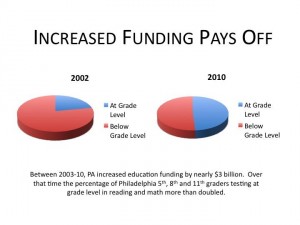Thanks to chronic underfunding from the State, the School District of Philadelphia is $81 million short of what it needs to open this year and hundreds of millions of dollars behind the full funding it needs to educate our children. المستعلم reports that the district, “was counting on a $2-per-pack cigarette tax that still requires approval by state officials. Lawmakers were supposed to return last week to approve the measure, but opted to cancel the legislative session and will not return until Sept. 15.”
Harrisburg may not yet be ready to offer solutions, but it’s having no problem finding excuses. The right-leaning Commonwealth Foundation recently claimed that Philadelphia students fail to improve when the district has more funding. But PCCY found that, when money was spent on research-proven practices, students across the school district showed marked improvement.
- Before the draconian education cuts of 2011, state funding for districts statewide rose every year from 2003 to 2010. In 2002, only 22% of Philadelphia students tested in grades 5, 8 and 11 were at “grade-level” in both reading and math. By 2010, that figure had more than doubled to 49%.
- In human terms, that’s 8,000 students in math and 7,000 in reading—that’s the equivalent of the entire Norristown School District.
But it wasn’t just Philadelphia. In 2009, the non-partisan Center on Education Policy found Pennsylvania to be the only state in America where students showed significant gains on rigorous national assessments in every grade and subject tested from 2002 to 2008. This isn’t a coincidence. New funds were targeted to research driven school reforms that were proven to boost student achievement, including the state expansion of pre-K and full-day kindergarten, tutoring for struggling students and using state funds specifically to reduce class sizes through third grade.
This isn’t a coincidence. New funds were targeted to research driven school reforms that were proven to boost student achievement, including the state expansion of pre-K and full-day kindergarten, tutoring for struggling students and using state funds specifically to reduce class sizes through third grade.
So how did the Commonwealth Foundation arrive at their conclusion? By including student data through 2013, two years after nearly $1 billion was cut from Pennsylvania schools.
Unsurprisingly, in those lean years student achievement tanked, wiping out the gains made over the previous eight years of budget growth. However, this brings up an important point: what happens when budgets get cut
- PCCY found that in 2010, more than half of all Philadelphia 5th graders were on grade level for math; three years later that figure dropped to 40%.
- Their reading proficiency saw a similar drop. For 8th graders, Philadelphia saw a drop from nearly 60% at grade-level in math to less than 50%.
When it comes to crises, like the one faced by the School District of Philadelphia, it is always easier to find reasons not to deal with the problem than to fix it. Opponents of funding the district in Harrisburg can cherry pick statistics as long as they want, it won’t chance the truth: proper funding, spent wisely, leads to increased student achievement. Cut that funding and the opposite happens. Full funding is not an option; it is an imperative for student success.
